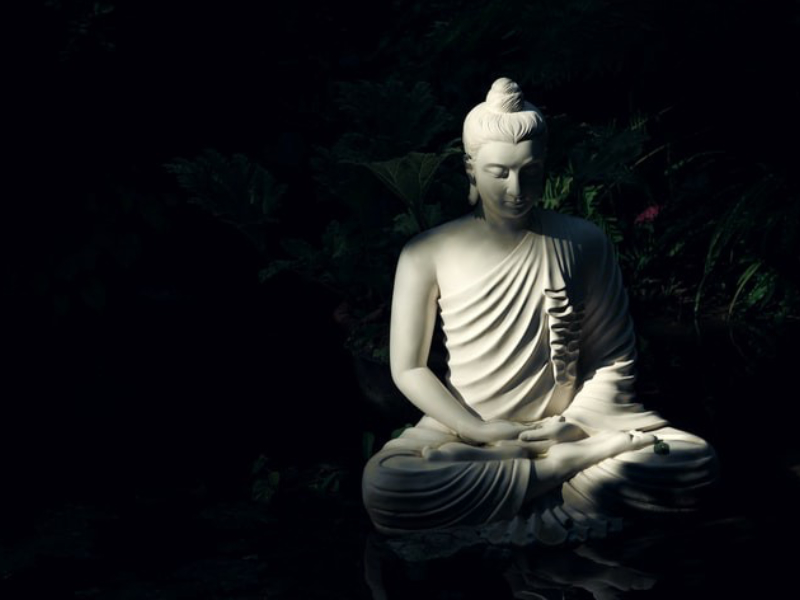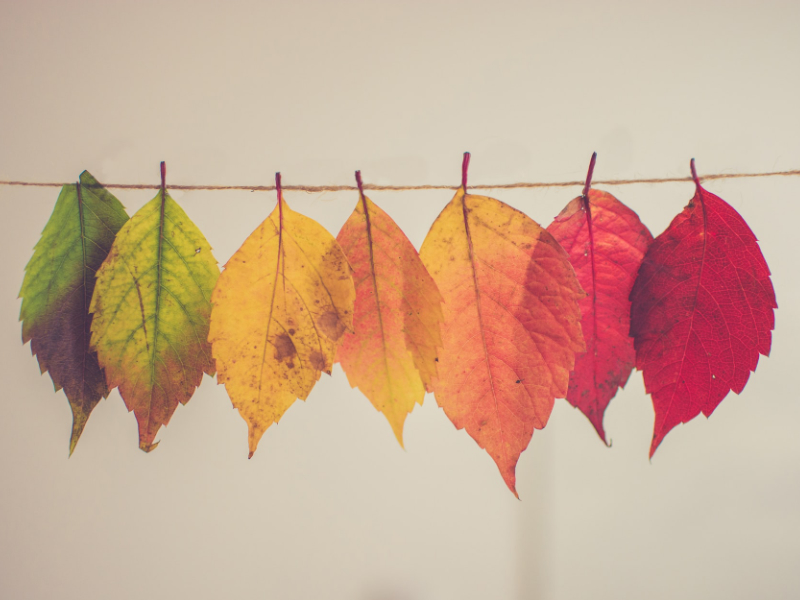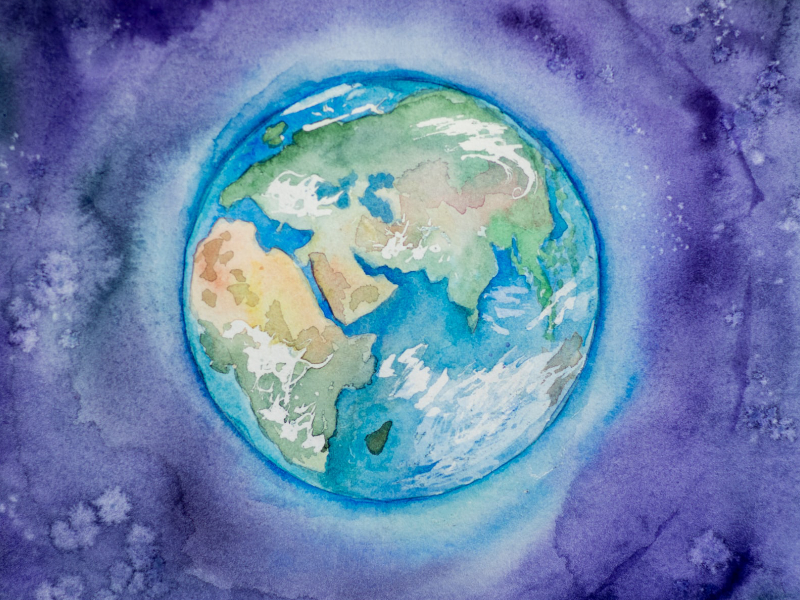The Art of Balanced Effort
– The Noble Eightfold Path | Training the Mind –

“Let only my skin and sinews and bones remain, let my blood dry up. I will not give up until I have accomplished what can be done by human effort and endeavor.” — The Buddha
EFFORT, MINDFULNESS, & CONCENTRATION
Today, we are going to explore how effort fits into the Buddha’s Noble Eightfold Path, which, if you recall, can be divided into three arenas of training: 1) training in wisdom, 2) training in virtue, and 3) training in cognition.
In the last episode, we finished the second arena of training, training in virtue, which encourages us to live in harmony with life so we can establish a peaceful heart. Establishing this peace of heart then sets us up for the final arena of training along the Path, training in cognition, which aims to bring our inner world into harmony so we can establish a sustained clarity of mind. It does this by cultivating 1) a skillful balance of effort, 2) a stable mindfulness, and 3) deep concentration.
Today, we will just focus on the first of these three, effort. But before we do, let me just emphasize that each of these — effort, mindfulness, and concentration — are interdependent. Each relies on and supports the other, just as each aspect of the Noble Eightfold Path relies on and supports the other, like spokes on a wheel.
To show this interdependence, there is also a parable in the comments to the Middle Length Discourses, a collection of Buddhist scriptures, about three kids playing at a park that, I think, captures this interplay well.
As the story goes, the kids see a tree with flowers at the top and want to pick them. But the flowers are out of reach. So, one friend bends down and says to stand on her back. The tallest kid climbs up but hesitates to reach for the flowers because he doesn’t have enough balance. So the third kid comes over and offers her shoulder for support. The first kid, standing on the back of the second kid, then leans on the shoulder of the third kid and is able to reach up and pick the flowers. (Papañcasudani, Commentary to Majjhima Nikaya).
The kid who picks the flowers represents concentration, which collects and unifies the mind. To collect and unify the mind, though, concentration needs support. It needs a boost of effort (the kid who offers her back) and the stability or equanimity of mindfulness (the kid who offers her shoulder). Only when concentration has this support can it then gather the scattered clouds of thought and fix the mind firmly on the objects of awareness.
Alright, well, keeping the interdependence of these cognitive faculties in mind, let’s go ahead and explore the art of balanced effort.
VIRIYA | EFFORT’S ROLE IN FREEDOM
To begin, I think it will be useful to consider the Pali word for ‘effort,’ which is viriya. Now, viriya is actually a much bigger word than effort alone. It has many nuances and flavors to it. So, when we speak of viriya, we can also think of it as energy, strength, courage, vigor, vitality, resolve, persistence, and perseverance.
In its most basic meaning, though, we can think of viriya as our capacity for activity, the power to get shit done, our will. As I said, it is the source of all achievement. Viriya, then, is intimately connected with our motivations and intentions. Together with mindfulness, it breaks us free from the inertia of our behavioral habits and tendencies of mind and allows us to move toward a more intentional life, whether our intentions are motivated out of self-interest or love.
This is important to understand because it suggests that viriya can either be the source of joy or dissatisfaction. It can lead onward to peace and freedom or into landscapes of suffering. You can use effort to try and take over the world, like Putin, or you can use it to develop generosity and kindness, like the Dalai Lama.
Effort Needs An Intention or Aim
For our purposes, we will apply viriya to free ourselves from suffering, to rid ourselves of greed, hatred, and delusion, to establish peace of heart and clarity of mind. We will apply effort to keep us on the path of Awakening. To be pointed, we will apply our effort to what are called the ‘Four Great Endeavors:’
- To prevent any unwholesome states from arising
- To abandon any unwholesome states that have already arisen
- To cultivate and develop wholesome states of mind
- To maintain and improve wholesome states that have already arisen
This, of course, is a tremendous aim, one that will last a lifetime. This is an important point. Viriya isn’t something that, once we have it, we have it for good. No, it takes continual adjustment to find the right balance, like walking a tightrope. It’s a refined art. We need to stay aware of our current state of mind and adjust to what’s needed at that time. The Buddha compared it to tuning a lute — the strings can’t be too tight or too loose.
The Art of Balanced Effort
So, when we tune this instrument of our mind, we need to strike the right balance. We need to find the sweet spot between effort and surrender. This may seem like a contradiction, but understanding this paradox is pivotal to our practice and vital wisdom to carry with us on our spiritual journey.
So, how can we have an aim or intention and, at the same time, avoid the trap, frustration, and energy drain of over-efforting and -striving?
This addresses one of the biggest misunderstandings of Buddhism I hear from people — that Buddhism just leads to surrender and total withdrawal from the world or from personal interests and endeavors, that it leads you to sink into a blissful meditative oblivion of oneness. This is so far from the truth. Here, surrender doesn’t mean passive resignation. It means that we surrender to the Dharma, that we face the truth of the present moment’s experience and not pretend things are otherwise.
This kind of acceptance still allows us to make effort, to work toward our goals and aims. And it does so without the grasping mind, without causing agitation to the system. It is an easeful effort that knows its aim but is not strained by expectation, strained by wanting things to go a certain way or to be a certain way. We can be mindful of the bigger perspective, our goal, but also stay present, open, relaxed, and responsive in each moment.
Joseph Goldstein uses the analogy of climbing a mountain, which needs a similar balance of perspectives. When you climb a mountain, you need to know your goal or aim, to hike to the peak of Mount Raymond, say, a local favorite of mine. But you also need to be aware of each step. You need to be aware of the terrain beneath your feet. Similarly, with our spiritual journey, we can keep our larger goal or frame in mind, while also paying precise attention to where we are in the moment, allowing us to balance our effort as needed.
So, how do we know if we’re applying too much or too little effort? Well, overstraining, desperation, expecting or wanting something to happen or be different are all signs that our effort is too tight. These are signs that we are in the wanting mind, whether expressed as greed or aversion. We are not open and receptive to experience or we are grasping, so we succumb to feelings of lacking, wanting, disappointment, frustration, restlessness, agitation, or despair.
Effort becomes unhelpful when there is a forcing of the mind rather than a relaxed, open, and receptive mind. Again, watch out for expectations or for any idea of gain you might be holding on to, the in-order-to-mind or the if-then mind. Are you leaning into or away from the next moment? Does the mind feel tight and contracted or does it feel open and receptive to what is here? Again from Goldstein, are you trying to push the river along?
If so, if the strings of effort are too tightly wound, we need to loosen them, we need to sink down and back, we need to soften our heart and open the mind. We need to give up some control and settle into the truth of the present moment. We need to work with and be with what’s there, with equanimity, interest, and compassion.
On the other hand, if you find that the mind feels lazy, lethargic, apathetic, dull, bored, or stagnant, this may be a sign more effort is needed. When energy is low, when we find ourselves in these mind states, easily drifting or falling into a daze, falling into mindless reveries or daydreams, we can leave ourselves vulnerable to delusion.
If that’s the case, if we find that our effort is too loose, we need to tighten it, we need to straighten our postures, check our attitude, and bring forward some strength, courage, patience, investigation, and/or perseverance. I actually just heard a funny story from Jack Kornfield, who said one of his teachers would have him sit on the edge of a deep water well to meditate when his energy was too low. That oughta straighten up your back and bring some energy to the system.
VIRIYA’S FUNCTIONS
Like I said, balancing our effort is an art. Have fun with it. And remember it will take time to learn the appropriate balance. But to support you, let’s explore some of the different forms and functions of viriya so you can start to play around with the dials and see what works best for you at various times along your way.
Strength & Support
One function of viriya is to provide strength or support. This dimension of viriya makes me think of the idiom ‘It takes a village.’ As I said earlier, there isn’t a single factor or faculty of mind that leads to freedom. It really does take a village. And when it comes to cultivating wholesome states of mind, the Buddha specifically mentioned seven, which are known as the Seven Factors of Awakening. They are: mindfulness, investigation, energy, joy, tranquility, concentration, and equanimity.
Viriya, in this form, serves to support these other factors, it shores them up. The second-century monk Nagasena, in his famous dialogues with the Indo-Greek King Milinda, describes viriya this way: “Just as, Your Majesty, someone might shore up a house that was falling down with an extra piece of wood so it would not fall down, even so, Your Majesty, viriya has the quality of shoring up; shored up by viriya, no skillful dhammas are lost.” (Milinda Pañha)
The Buddha emphasized something similar in the Dhammapada, saying, when we put in the effort and practice, wisdom grows; and when we don’t, wisdom wanes. So, like I said earlier, it is this quality of viriya that keeps us on the path of Awakening. It supports wisdom from waning.
“Here, the noble disciple dwells as one who has produced strength; for the sake of abandoning unskillful dhammas and arousing skillful dhammas one is firm, of steady valor, un-relinquishing in purpose with regard to skillful dhammas.” — The Buddha
Courageous Effort
Another aspect of viriya is courage, an unrelenting expression of heart. This quality of viriya is profoundly energizing and is absolutely crucial when, at times along our path, we run into difficult landscapes of mind that make us want to retreat to a place of comfort.
While the hindrances sloth and torpor cause us to retreat from challenges, courage does the opposite. It is energized by challenges, inspired by them. When we cultivate viriya in this form, we are able to rise to the occasion and move onward to our aim. It doesn’t mean we aren’t scared or that we don’t have doubts. It means we are willing to act in the face of those fears, in the face of those doubts. It welcomes fear and doubt, and understands them as necessary elements to our growth.
“The only time a man can be brave is when he is afraid.” — Ned Stark, Game of Thrones
Some famous examples of people who demonstrate this quality of courage include Nelson Mandela, Gandhi, Martin Luther King, Socrates, and Jesus. In Jesus’s unwavering commitment to love, while his hands and feet were nailed to the cross, he cried out, “Father, forgive them.” Jesus had many opportunities, as well as every reason, to retreat from Jerusalem, to escape persecution. But courage kept him on his path, to become a living symbol of love and self-sacrifice not only for his people but for all humankind.
Now, you may be thinking, ‘Well sure, Jesus can do this. But he’s Jesus, the Son of Man. I’m just a plain Jane.’ This quality of courage, though, isn’t reserved for saints and legends. Nor is it fixed, something you have or you don’t. It’s a quality of mind that can be cultivated and strengthened.
And we see it everywhere in the hearts and minds of ordinary folk like you and me. We see it in mothers, who sacrifice their bodies, their time, and their careers for their children. We see it in extreme athletes, like the Wim Hofs of the world, who continually test the limits of their bodies. We see it in our school teachers, who keep showing up for their students, despite their low pay. We see it in our police officers, firefighters, and other first-responders. We see it in the women who spoke up against offenders in the Me Too movement. We see it right now in the people protesting in Iran for basic human rights.
You too can cultivate this quality of courage. It will just require you to come to the boundary of your comfort levels and briefly peak over the edge. It takes courage to challenge ourselves, to extend our limits, to really see what is possible. As the Burmese meditation master Sayadaw U Tejaniya said:
“Avoiding difficult situations or running away from them does not usually take much skill or effort. But doing so prevents you from testing your own limits and from growing. The ability to face difficulties can be crucial for your growth. However, if you are faced with a situation in which the difficulties are simply overwhelming, you should step back for the time being and wait until you have built up enough [viriya or courage] to deal with it skillfully.” — Tejaniya, Don’t Look Down on the Defilements, 57.
This is wise advice. We don’t want to simply jump into a situation without giving it any thought. We want to discern with wisdom whether doing so is a skillful means to our end — liberation. Sometimes, it isn’t. Sometimes we simply aren’t ready, and facing the challenge will just lead to more suffering. So, we need to step back and seek out some smaller wins before we come back to it.
There are some small practical ways you can start to cultivate this element of viriya. With our meditation practice, for example, you can sit for just a few minutes longer than you are comfortable with, and notice the energy that comes from teasing the boundary. Or, you can commit to not move a muscle during one of your sits, no matter how uncomfortable you may get.
You can also learn about this element of viriya from one of the greatest teachers I know — the cold. You can do polar plunges or maybe just turn the shower water to the coldest setting for the last thirty seconds, and really take an interest in the mind as it faces that discomfort. There are bonus points here too — science is telling us that this helps boost our immunity against the common cold, increase circulation and metabolism, and reduce inflammation, all of which lead to a longer, healthier life.
Or maybe for you strengthening your courage means putting yourself out there socially, pushing that comfort level. You can face your fear of rejection and try to make some friends, or ask that cute guy you keep thinking of to grab dinner with you. Or, you can put your art or writing out into the world, even though you fear people won’t like it or appreciate it. Or maybe you can apply for that job you’ve always wanted, but haven’t because you fear you’ll get turned down.
I really came to explore this dimension of viriya out on the mountains with my Snow Leopard. Every summer solstice we would hike a bit further than we ever had. Near the beginning, for one of our first summer solstice adventures, we hiked a trail here in the Wasatch called Desolation Trail, an 18-mile hike to Desolation Lake, where we camped for the night before making the 18-mile trek home. The next year, we went there and back in the time the sun was up, clocking in 36 miles in one day. And the next year, we did 48 miles in two days, bagging six peaks over ten thousand feet. Before each of these hikes, and even during them, there was a big part of me that thought there was no way I could do it. But each time, this courageous dimension of viriya came to the rescue and gave me the energy I needed. It showed me that my body is capable of so much more than I had imagined.
If you need some energy in your life, seek out some challenges. Play at the boundaries of your comfort levels. Know what you want and go out and get it, despite your doubts and fears.
Let the bodhisattva’s roar of courage motivate you:
“Let only my skin and sinews and bones remain, let my blood dry up. I will not give up until I have accomplished what can be done by human effort and endeavor.”
Perseverance & Resolve
The final dimension of viriya we’ll explore today is perseverance. Where courage gives us strength to face challenges, perseverance keeps us going. This dimension of viriya is not one to be underestimated. It is vital to our goal of liberation, which, as I said, is a life-long commitment and journey. Suzuki Roshi, in Zen Mind Beginners Mind, says:
“After you have practiced for a while, you will realize it is not possible to make rapid extraordinary progress. Even though you try very hard, the progress is always little by little. It is not like going out in a shower, in which you know when you get wet. In a fog, you do not know you’re getting wet. But as you keep walking, you get wet little by little. If your mind has ideas of progress, you may say, ‘oh, this pace is terrible,’ but actually it is not. When you get wet in a fog, it is very difficult to dry yourself, so there is no need to worry about progress. Just be sincere and make full effort in each moment. This is enough.”
This is how practice works. It takes time. You can’t just learn to rhyme like Eminem over night. He’s been at it consistently for years. The other rappers who collaborate with him are astonished at the effort he puts in, saying he treats it like a 9–5 job, with only a 30-minute lunch break. Despite what some Buddhist suttas say about people becoming fully Enlightened at the snap of a finger, it takes time to master the hindrances, to free ourselves of greed, hatred, and delusion, to free ourselves from suffering. Our practice unfolds steadily over time when we apply this persevering dimension of viriya.
I heard another great story from Goldstein, whose book Mindfulness I’ve been pulling a lot from for these episodes on the Noble Eightfold Path. Anyway, he tells a story about the famous Tibetan master Milarepa, who, as legend has it, at a young age went on a revengeful killing spree at his mother’s request. And then, later in his life, when he encountered the Buddha’s teachings, he realized he needed to get enlightened or else his karma would catch up to him. So, he went and lived in a cave until he perfected his heart and mind, and then spent the rest of his life teaching.
Over the years, Milarepa grew very close to his chief disciple and shared many of his teachings with him. But the chief disciple thought Milarepa was saving the highest teaching, the real esoteric teaching, the secret transmission, for the end. So, not long before Milarepa died, the two of them treked off to some remote place in the mountains. And when they got there, Milarepa had the chief disciple set everything up perfectly, really setting the stage for something special. The disciple was stoked, super eager to receive the secret transmission.
So, when everything was ready, Milarepa came very close to his disciple… bent over, lifted his robe, and showed his disciple the calluses on his ass — the secret transmission: viriya in the form of perseverance.
What’s the secret to success? Put in the work and don’t give up.
The long-game can be tough at times, no doubt. Whether it’s raising kids, going to school, maintaining a relationship, putting in the years to get your dream job, working through grief, or just sticking with your spiritual practice, there will inevitably be times when we run low on hope and fuel. So, here are a few tools to keep in your bag for when you find yourself in those situations and need a little viriya in the form of perseverance.
First, see if you can connect again to what first sparked your interest in your journey. Was it some personal experience, maybe of tremendous joy or interest, or maybe of suffering? Was their a deep thirst for meaning or purpose in your life? A thirst for freedom or understanding? Was it compassion for another? Whatever it was, see if you can reconnect with this motivation, interest, or inspiration. Let it rekindle some fire in you.
Second, you can try contemplating the inevitability of death and the preciousness of this human life. We too often take advantage of the unbelievable conditions, this miracle, we’ve been given — this precious human birth, body, and experience. Somewhat unconsciously, we think we’ll never run out of time or that we’ll be able to pursue our interests or deepest passions later. But, thinking the conditions will always be favorable is simply a delusion. Anything can happen at any time. And eventually, we can’t avoid it. We will get sick. We will grow old. And we will die.
Just a couple weeks ago, we had our friend over to our place. And that night she was working through a headache, which she expressed had been there for a couple weeks. A few days later, the headaches got bad enough to make her go to the hospital. Turns out, her entire life changed in a moment. She was diagnosed with a diffuse midline glioma, an aggressive and rare type of brain tumor.
Our life, this human body, this experience, this very moment, is precious. The Buddha said, “We have arrived at a great treasure island,” the treasure island of this precious human birth. Here, now, with this body, with this life, with this opportunity, we can come to understand and cultivate all the causes of peace, happiness, and freedom.
“Cherish your body. It is yours this one time only. The human form is one with great difficulty. It is easy to lose. All worldly things are brief, like lightning in the sky. This life, you must know, is a tiny splash of a raindrop, a thing of beauty that disappears even as it comes into being. Therefore, set your aspiration and make use of every day and night to achieve it.” — Tsongkhapa, 14th Century Monk
May you love and cherish yourself. May you be grateful for this precious human life. May you hold its ten thousand joys and its ten thousand sorrows with love, care, and compassion. May you truly be at peace,
More Articles
“The Art of Bare Attention”
Today we’re going to talk about the ancient Buddhist practice vipassana, or insight meditation. Now, just to be clear, this is an entirely secular practice. It doesn’t require you to adopt any dogmatic beliefs…
“The Faceless Seer”
How do you hold your love? Do you hold her from stillness, with nowhere to go, with nothing to do? How do you hold your love? Do you hold her with acceptance, with open hands and arms, with unabashed…
“Everything Changes”
It’s no secret everything changes. Your experience this morning isn’t your experience now. Yet how many of us act like we really understand this? How often do we grasp onto the illusion of things…
“The Divine Connection”
How do you hold your love? Do you hold her from stillness, with nowhere to go, with nothing to do? How do you hold your love? Do you hold her with acceptance, with open hands and arms, with unabashed…






